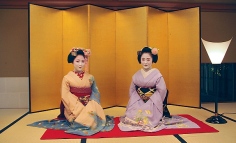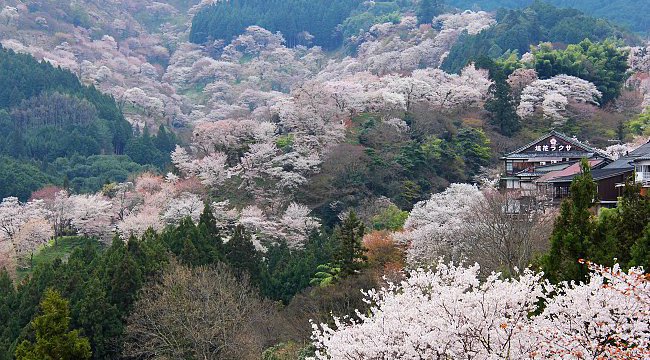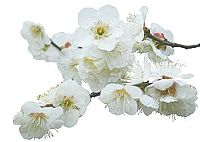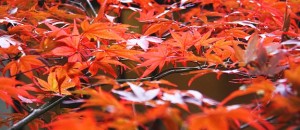Source: http://www.japan-guide.com/e/e638.html
Kimono and yukata are traditional Japanese clothing.
Kimono are made of silk and are usually very expensive. Nowadays they are worn at formal or traditional occasions such as funerals, weddings or tea ceremonies. Only rarely kimono can still be seen in everyday life.
kimono can still be seen in everyday life.
Kimono differ in style and color depending on the occasion on which it is worn and the age and marital status of the person wearing it. To put on a kimono needs some practice. Especially tying the belt (obi) alone is difficult so that many people require assistance. Wearing a kimono properly includes proper hair style, traditional shoes, socks, underwear, and a small handbag for women.
The yukata, on the other hand, is more of an informal leisure clothing. It is a comfortable dress on summer days or after a hot bath. Yukata are relatively inexpensive and made of cotton. While staying at a ryokan, you will be provided with a yukata.
The tea ceremony
 (sado: “the way of the tea”) is a ceremonial way of preparing and drinking tea. The custom has been strongly influenced by Zen Buddhism.
(sado: “the way of the tea”) is a ceremonial way of preparing and drinking tea. The custom has been strongly influenced by Zen Buddhism.
Nowadays, the tea ceremony is a relatively popular hobby. Many Japanese, who are interested in their own culture, take tea ceremony lessons. Tea ceremonies are held in traditional Japanese rooms in cultural community centres or private houses.
The ceremony itself consists of many rituals that have to be learned by heart. Almost each hand movement is prescribed. Basically, the tea is first prepared by the host, and then drunk by the guests. The tea is matcha green tea made of powdered tea leaves.
Geisha (Geiko)
Geisha (or geiko in Kyoto dialect) are professional entertainers who attend guests during meals, banquets and other occasions. They are trained in various traditional Japanese arts, such as dance and music, as well as in the art of communication. Their role is to make guests feel at ease with conversation, drinking games and dance performances.
Where does the geisha culture survive?
Geisha can be found in several cities across Japan, including Tokyo and Kanazawa, but the former capital of Kyoto remains the best and most prestigious place to experience geisha, who are known there in the local dialect as geiko. Five major geiko districts (hanamachi) remain in Kyoto. Four of them, Gion Kobu, Gion Higashi, Miyagawacho and Pontocho, are located in or around the Gion district in central Kyoto, while the fifth, Kamishichiken, is located near Kitano Tenmangu Shrine.
Geiko and geiko aspirants live in special houses (okiya) in the geiko districts. In Kyoto, young girls move there typically at age 15 to be taught communication and hospitality skills and various traditional Japanese arts. After an introductory training and examination, the talented and determined will go on to become a maiko (geiko apprentice) and eventually a geiko a few years later.
 Gion’s Hanami Koji (left) and Pontocho (right)
Gion’s Hanami Koji (left) and Pontocho (right)
Where do geiko dinners take place and who can attend?
The typical location for a geiko dinner are ochaya (tea houses), another important element of geiko districts. The ochaya provides just the tatami room where the dinner takes place, while the food and the geiko themselves are ordered from the outside. Ochaya are highly exclusive places due to their traditional way of doing business and will grant entry to trusted customers only.
Unlike a regular restaurant, an ochaya does not bill its guests at the end of the evening. Rather it adds the entire evening’s expenses, including the costs for the room, food, geiko and taxi rides, to a running tab, and charges the customer’s bank account once per month. Since this system is obviously based on a trust relation, new customers are only accepted if an existing customer serves as their guarantor.
A former ochaya in Kanazawa’s Higashi Chaya district, the Shima Ochaya, has been opened to the public as a museum, allowing tourists to see a traditional ochaya from the inside, including the tatami rooms and exhibits of utensils, accessories and music instruments.
 The facade of the Shima Ochaya (left) in the Higashi Chaya district of Kanazawa
The facade of the Shima Ochaya (left) in the Higashi Chaya district of Kanazawa
What happens at the ochaya?
Participants at a geiko dinner eat and drink while being entertained by the maiko and geiko. The task of the maiko and geiko is to engage in witty conversation with their guests, while keeping everybody’s glasses filled. Another element of a geiko dinner are a whole range of games in which the loser usually has to drink up another glass of beer.
The cultural highlight of the evening is the geiko’s performance of a seasonal dance, accompanied by traditional music, typically played on the shamisen by another geiko. The total number of geiko and maiko present depends on the party’s size and the customer’s budget.
 A maiko and two geiko during a dance performance at an ochaya in Gion
A maiko and two geiko during a dance performance at an ochaya in Gion
How can regular tourists participate in a geiko dinner?
Geiko dinners have always been exclusive and expensive, high class events. But like other businesses, the ochaya have been suffering from the economic downturn in recent decades. As a result, they have become less restrictive, and it is now possible for almost any tourist with a sufficient budget to have a dinner with a geiko thanks to travel agencies and hotels serving as the go-between. There are even a few companies which target foreign tourists without Japanese language skills.
If you book through a travel agency, the typical cost for a full fletched geiko dinner is around 50,000 yen per maiko or geiko plus the cost for the meal which is typically between 10,000 and 30,000 yen per person. Since English conversation is not among the skills learned by geiko (they are supposed to communicate in Kyoto dialect only), some services can arrange an interpreter at an additional cost.
 A foreign tourist challenges a maiko in a popular ochaya game
A foreign tourist challenges a maiko in a popular ochaya game
What are other ways to experience the geiko culture?
There are some other ways for people with a smaller budget to experience the geiko culture. The easiest is to watch a daily performance at the Gion Corner, a theater which targets foreign tourists with performances of a wide variety of Japanese arts, including a maiko dance.
During the month of April, the Miyako Odori is an even better opportunity to watch dance performances by maiko and geiko. There are four one hour performances held every day on the stage of the Gion Kobu Kaburenjo theater in Gion for 2000 or 4000 yen per person.
A popular service in Kyoto these days is to get dressed up as a maiko or geiko. There are maiko studios all over the city, resulting in quite a few “fake maiko” on the streets of  Kyoto around popular sightseeing spots during daytime. Some studios also target foreign tourists, and a typical experience costs around 10,000 yen per person including photos in the studio or outdoors.
Kyoto around popular sightseeing spots during daytime. Some studios also target foreign tourists, and a typical experience costs around 10,000 yen per person including photos in the studio or outdoors.
Last but not least, with a bit of luck it is possible to spot a real maiko or geiko in the streets of Kyoto, especially in the evenings around Gion or Pontocho. However, if you spot a geiko, act respectfully. Complaints about tourists behaving like ruthless paparazzi are on the increase in recent years.
Two women in maiko outfit in the Higashiyama district
Gardens
Cherry Blossoms (Sakura)
The cherry blossom (sakura) is Japan’s unofficial national flower. It has been celebrated for many centuries and holds a very prominent position in Japanese culture. There are many dozens of different cherry tree varieties in Japan, most of which bloom for just a couple of days in spring. The Japanese celebrate that time of the year with hanami (cherry blossom viewing) parties under the blooming trees.
Guide to Cherry Blossom Viewing:
How to do cherry blossom viewing?
When do the cherry blossoms bloom?
Popular cherry blossom spots
Cherry tree varieties
Japanese Plum
Autumn leaves (koyo)
The 2013 autumn color reporting is scheduled to start on September 20, 2013.
Colorful leaves (koyo) are to the Japanese autumn what cherry blossoms are to spring. The viewing of autumn leaves has been a popular activity in Japan for centuries and today draws large numbers of travelers to famous koyo spots both in the mountains and in the cities.
Each year, starting in mid September, the “koyo front” slowly moves southwards from the northern island of Hokkaido until it reaches the lower elevations of central and southern Japan towards the end of November. Some trees around Tokyo and Kyoto remain colorful into early December.
Guide to Autumn Colors:
Where to see autumn leaves?
When do trees turn colors?
What trees turn colors
Traditional Music
There are several types of traditional, Japanese music (hogaku). Some of the most important ones are listed below:
Gagaku: Ancient court music from China and Korea. It is the oldest type of Japanese, traditional music.
Biwagaku: Music played with the Biwa, a kind of guitar with four strings.
Nohgaku: Music played during Noh performances. It basically consists of a chorus, the Hayashi flute, the Tsuzumi drum, and other instruments.
Sokyoku: Music played with the Koto, a type of zither with 13 strings. Later also accompanied by Shamisen and Shakuhachi.
Shakuhachi: Music played with the Shakuhachi, a bamboo flute that is about 55 cm long. The name of the flute is its length expressed in shaku an old Japanese unit of length.
Shamisenongaku: Music played with the Shamisen, a kind of guitar with only three strings. Kabuki and Bunraku performances are accompanied by the shamisen.
Minyo: Japanese folk songs.
Sumo
|
Public Bath
 Large public bath (Ichinoyu) in Kinosaki Onsen
Large public bath (Ichinoyu) in Kinosaki Onsen
In the past, many homes in Japan were not equipped with a bathtub. To fill this void, the neighborhood sento (lit. money hot water), or public bath was a place where the locals could go to wash themselves, soak in a tub and socialize with neighbors.
Nowadays, as most households have their own bath, the number of traditional sento has decreased. However, new types of public baths and bath complexes, which feature a range of different pools, saunas, fitness centers, etc. have been emerging, some of which more resemble theme parks than simple bath houses.
Some sento, typically in hot spring resort towns, utilize natural hot spring water for their baths. In this case they are considered an onsen bath. Public baths that are not supplied by hot spring water, use heated tap water instead.
Public baths (public in that anyone may use them as opposed to the private baths of ryokan and hotels which may only be open to guests) can be found throughout Japan and typically cost 200 to 2000 yen. Some, found in larger cities, are open 24 hours with special overnight rates, and can be used as alternative budget accommodation.
With the exception of some theme park style bath complexes, public baths are segregated by gender and swimsuits are not worn. More information on bathing rules can be found here.
Festivals (Matsuri)
 Awa OdoriThere are countless local festivals (matsuri) in Japan because almost every shrine celebrates one of its own. Most festivals are held annually and celebrate the shrine’s deity or a seasonal or historical event. Some festival are held over several days. Awa OdoriThere are countless local festivals (matsuri) in Japan because almost every shrine celebrates one of its own. Most festivals are held annually and celebrate the shrine’s deity or a seasonal or historical event. Some festival are held over several days.
An important element of Japanese festivals are processions, in which the local shrine’s kami (Shinto deity) is carried through the town in mikoshi (palanquins). It is the only time of the year when the kami leaves the shrine to be carried around town. Many festivals also feature decorated floats (dashi), which are pulled through the town, accompanied by drum and flute music by the people sitting on the floats. Every festival has its own characteristics. While some festivals are calm and meditative, many are energetic and noisy. Below follows an incomplete list of some of Japan’s most famous festivals and celebrations. Exact dates are available on the event calendar. |
Annual events
| The following are Japanese national holidays and some of the most important other annual nationwide events. In addition, there are countless local annual festivals.If a national holiday falls on a Sunday, the following Monday is also turned into a holiday. Likewise, a day sandwiched between two national holidays is turned into a holiday.
Shops, restaurants and tourist attractions in Japan are generally open on national holidays, except on New Year. Please consult our event calendar for exact dates. |
Cormorant Fishing (Ukai)
 Cormorant fishing in Arashiyama
Cormorant fishing in Arashiyama
Ukai is a traditional fishing method which uses trained cormorants to catch river fish such as sweetfish (ayu). This type of fishing has been around for over 1300 years, most prominently along the Nagaragawa River in Gifu City, where the master fishermen have official patronage from the emperor. Today, ukai takes place in the summer months in about a dozen rivers across Japan, including:
Nagaragawa River, Gifu City, May 11 to October 15
Hozu River, Arashiyama, Kyoto City, July to mid September (2013: 7/1 to 9/16)
Uji River, Uji City, mid June to late September (2013: 6/15 to 9/23)
Ukai is practiced by master fisherman working from long wooden boats. Each fisherman leads about a dozen cormorants on leashes who swim alongside the boat and dive under the water to catch fish by swallowing them whole. The fish are kept in a special pouch in the cormorant’s throat to be retrieved later and are prevented from being swallowed by a snare around the neck of the bird. Each boat has a large fire that hangs from its bow to provide light for the boatmen to steer and the birds to fish by.
These days, ukai is held mainly as a tourist attraction. Special sightseeing cruises are offered that shadow the ukai boats and allow tourists to get an up-close look at the action. Details depend on each site, but the boats typically operate daily during the season except when the rivers have high water levels. Cruises typically last about an hour and cost around 1500 to 3500 yen per person.
Dinner cruises are also available at some of the ukai sites and provide a unique and popular way of experiencing ukai. Dinner cruises may be offered through the cruise companies themselves or through local hotels, ryokan and restaurants. Advance reservations are usually required. Alternatively, in many places it is also possible to watch the fishing action from along the riverbank for free.
Calendar
With the year 1873, the Gregorian calendar was introduced to Japan. While the Christian way of numbering years is commonly used in Japan today, a parallel numbering system for years based on the reigns of emperors is also frequently applied (see year converter above).
The year 2000, for example, which happened to be the 12th year of the reign of the current emperor, whose posthumous name will be Heisei, is called “Heisei 12”.
Before 1873, lunar calendars, which were originally imported from China, were used in Japan for many centuries. The lunar calendars were based on the cycle of the moon, resulting in years of twelve months of 29 or 30 days (the moon takes about 29 1/2 days to circle the earth), and an occasional 13th month to even out the discrepancy to the solar cycle of 365 1/4 days, i.e. the discrepancy to the seasons.
Various features of the lunar calendar remain intact in today’s Japan. For example, years are still commonly associated with the twelve animals: mouse, cow, tiger, rabbit, dragon, snake, horse, sheep, monkey, rooster, dog and pig.
Another aspect of the lunar calendar, that survives into modern Japan, is the subdivision of the calendar into six days (rokuyo), similar to the subdivision of the modern calendar into seven weekdays. The six days are called taian, butsumetsu, senpu, tomobiki, shakko and sensho, and they are associated with good and bad fortune.
Taian, for example, is considered the most auspicious of the six days and ideal for holding business or personal events such as wedding ceremonies, while butsumetsu is considered the least auspicious day, and holding funerals is avoided on tomobiki.



 Originally introduced from China, the Japanese plum (梅, ume; sometimes referred to as Japanese apricot) has played an important role in Japanese culture for many centuries. Its popularity was eventually surpassed by that of the cherry tree.
Originally introduced from China, the Japanese plum (梅, ume; sometimes referred to as Japanese apricot) has played an important role in Japanese culture for many centuries. Its popularity was eventually surpassed by that of the cherry tree.





